Roosevelt’s Soil Soldiers” 1933-1942
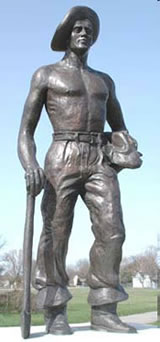 STATUE NO. 50. Dedicated
February 21, 2009 - Phoenix South Mountain Park, coordinated by members of CCC
Legacy Chapter #44 and donated by Jack Duncan, Chapter member. The statue is
located at the entrance to the visitors center of the Phoenix South Mountain
Park
STATUE NO. 50. Dedicated
February 21, 2009 - Phoenix South Mountain Park, coordinated by members of CCC
Legacy Chapter #44 and donated by Jack Duncan, Chapter member. The statue is
located at the entrance to the visitors center of the Phoenix South Mountain
Park
On March 4, 1933, as Franklin D. Roosevelt was sworn into office as the
thirty-second President of the United States, he willingly accepted the
challenges of leading the nation out of the depths of its greatest economic and
social depression. The unemployment rate had surged from three percent in 1929,
to an astonishing twenty-five percent (The Civilian Conservation Corps and the
National Park Service). Roosevelt promised that he would launch a series of
emergency programs to help put Americans back to work. One of the most
successful programs was the Emergency Conservation Work Act (ECW), which later
came to be known as the Civilian Conservation Corps.
Operating under a dual mission of putting Americans back to work (especially
young men) and protecting the nation’s natural resources (Oregon State
Archives), the Emergency Conservation Work Act was pushed through Congress and
the first enrollee was inducted into the CCC on April 7, 1933 (A Brief History
of the Civilian Conservation Corps). Enrollment was open to young men who were
unemployed, unmarried, and between the ages of 18 and 23 years of age.
Conditions required performing intense physical labor, but the enrollees did not
mind, they were eating three hearty meals each day, learning valuable trade
skills, and earning money. The men would enroll for a six-month term, with the
option of re-enrolling for additional six-months, up to two years. Enrollees
would receive a monthly salary of $30, of which $25 must be sent home to
desperate family members.
A Depression era soup line. The unemployment rate had surged from 3% in 1929 to an astonishing 25%
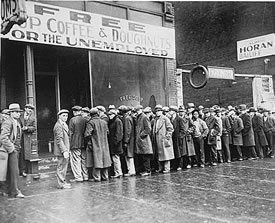
Over time, enrollment restrictions would be
changed to employ a wider range of young men including, World War I veterans and
Native Americans. At the peak of enrollment in 1935, over 500,000 men were
employed in more than 2,600 camps across the country, including Alaska, Hawaii,
and the Virgin Islands. The $25 allotment sent an estimated $72,000,000 back
into the nation’s economy as the needy families of enrollees spent it making
life a little easier. Additionally, camps added an average of five thousand
dollars a month into the local market with the purchase of supplies to keep the
camps in operation (A Brief History of the Civilian Conservation Corps).
A joint cooperation between numerous government agencies was required to
bring the CCC into existence and keep the program running smoothly throughout
its nine-year span. The War Department, the Department of the Interior, the
Department of Agriculture, and the Department of Labor were just a few of the
initial agencies involved, shortly followed by the Office of Education. Each
government agency was responsible for daily operations; the War Department
oversaw enrollees while in the camp. The Department of Interior often would
oversee the enrollees when they were off site, at the work location, and the
Office of Education ran the vocational training, which offered voluntary courses
in the evenings.
The population of each camp generally ranged from 150 to
250 men who were under the command of military personnel while in camp. The
workday for enrollees began around 6 a.m. with the wakening sound of the bugle.
After the barracks were inspected, the men would march off to breakfast and
morning roll call. After morning assignments and announcements were finished,
the enrollees were released under the direct supervision of the technical
service of which their agency was assigned.
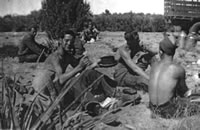 Noon chow usually consisted of
a bag lunch
Noon chow usually consisted of
a bag lunch
The meal was usually a bagged lunch consisting of sandwiches, fruit, coffee,
and occasionally pie or cake. After the midday lunch break, the men would
continue with their work until about 4 p.m. when they would go back to camp
either by foot or aboard work trucks.
Once enrollees we back in camp they were normally required to attend a
“retreat” formation at 5 p.m. as the flag was lowered for the day. Retreat was
followed by the evening meal. After dinner, the men were not held to a standard
schedule. They were free to attend educational classes and lectures, participate
in recreational activities, such as playing pool or baseball, or just sitting
around listening to the radio, writing letters, or talking. Around 9:45 p.m.,
the lights would flash on and off to signal enrollees to prepare for lights out
at 10 p.m.
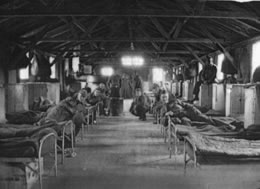
Home was barracks with cots. The men would typically work an eight hour day with an hour taken for the noon lunch which was normally served in the field.
Throughout the years of the CCC, countless hours of work was conducted to
improving the recreational facilities of numerous national, state, county, and
municipal parks. In addition to the recreational improvements performed by the
CCC enrollees, the men focused on conservation work in the undeveloped areas of
the country. The projects centered on reforestation, flood control, prevention
of soil erosion, and fighting forest fires. According to the National
Association of Civilian Conservation Corps Alumni the figures listed below are
just a few of the contributions made by the CCC:
125,000 miles of roadway
89,000 miles of
telephone line strung
13,100 miles of foot trails
40 million acres of
farmlands that benefited from erosion control projects
154 million square
yards of stream and lake bank protection
814,000 acres of range
re-vegetation
800 state parks developed
52,000 acres of public campground
development
3 billion trees planted\
3,470 fire towers erected
97,000
miles of fire roads built
Disease and insect control
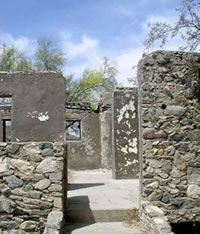
Remnants of the CCC camp stone
buildings remain today
Between 1933 and 1940, four thousand (4000) men worked out of two camps at
South Mountain Park. During this time the men constructed over 40 miles of
hiking and equestrian trails, 18 buildings, 15 ramadas, 134 fire pits, 30 water
faucets, water dams, and other features within the park. The architectural style
for the buildings built at South Mountain Park between 1933 and 1937 was a
cooperative effort between the National Park Service and the City Parks
Supervisor. The slab stone masonry buildings were consistent with the Park
Service’s use of regionally traditional themes utilizing environmentally
compatible materials. See list of Arizona CCC Projects.
Despite the contributions made by the CCC enrollees, Americans began to
question the need for the program as the nation’s economy began to improve and
the availability of jobs became more widespread. The program was still held in
high regards but many believed that the workers should be transferred into
factories or the expanding armed forces. On December 7, 1941, the Japanese
attack on Pearl Harbor shifted America’s focus to the war effort and soon a
number of CCC camps had been assigned to work on military bases. By June of
1942, congress had agreed to eliminate all funding for the program, thus ending
its nine years of existence.
Programs such as the CCC helped move America through the Great Depression. It
proved to be a source of training and discipline for countless young men whose
next battle would not be an economic fight waged in the forests and fields, but
a very real shooting war fought in far-off lands where training, discipline, and
respect for authority meant the difference between life and death.
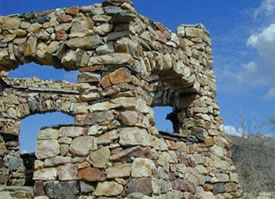
CCC building still in use at the end of San Juan Road
Sources
“The Civilian Conservation Corps and the National Park Service, 1933-1942: An
Administrative
History.”
http://nps.gov/history/history/online_books/ccc/ccc1.htm (06, Dec.
07)
“Oregon State Archives 50th Anniversary Exhibit; The Civilian Conservation
Corps: Protecting Oregon’s
Resources.”
http://arcweb.sos.state.or.us/50th/ccc/cccintro.html (06, Dec.
07)
“A Brief History of the Civilian Conservation
Corps.”
http://www.cccalumni.org/history1.html (06, Dec. 07)
Smith, Michael I. The Civilian Conservation Corps: Roosevelt’s Forest Army,
1933-1942.
“Civilian Conservation
Corps.”
http://en.wikipedia.org/wiki/Civilian_Conservation_Corps (06, Dec.
07)

